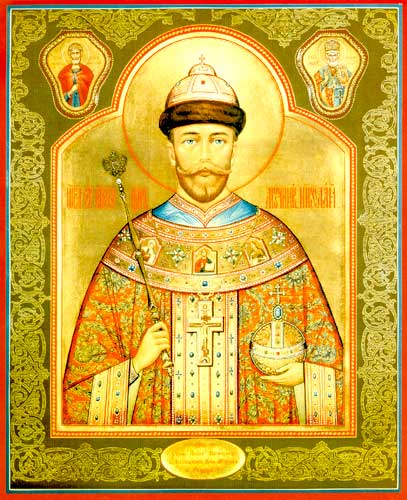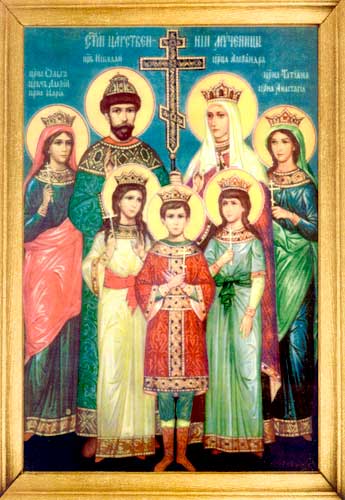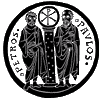the Martyrdom of the Russian Royal Family, July 4/17, 1918
The following item is adapted from two articles: "Two Myrrh-Gushing Icons in Moscow," appearing in Church News, (Vol 11, No. 2, March-April 1999, pp. 7-8), and "Miracle in Moscow," Orthodox Life, (Vol. 49, No. 1, January-February 1999) pp. 37-41. The ultimate source of information on this subject as reported by Church News is Russky Vestnik, #48-49, a 50-page booklet published by a Russian Community honoring the Theotokos "Vzyskaniye Pogibshikh," and Ecumenical News International, February 17 (no further bibliographic data given). Orthodox Life credits as its source Vertograd-Inform (No. 1 (46), a Russian Synod publication in Russia. [The pictures shown here are not the icons described in this article.]
According to Church News, it was reported last year that two icons had begun streaming myrrh. The icons are lithographs (paper icons) produced originally in America (location of production not given). They depict (1) Tsar Martyr Nicholas and (2) the Holy Royal Martyrs. On the sides of the first icon are depictions of St. Nicholas the Wonderworker and St. Job the Much-suffering.There are discrepancies in the explanations of who delivered the icon of the Tsar Martyr to the Russian Church, and exactly how the icons came to the attention of the world.
The Church News ExplanationOn March 15, 1998 two guests, George Balovlenko and Oleg Ivanovich Belchenko, came from Moscow to the city of Ryazan to participate in the feast of the miraculous icon of the Theotokos "Derzhavnaya" (Sovereign) at a church attached to a shelter for the poor dedicated to St. Nicholas the Wonderworker. At that time both guests were blessed with the icons by the rector of St. Nicholas Church. Balovlenko received an icon of the Royal Family (enlarged color photocopy, size 26 x 40 cm. [10 x 16 in.]), and the surgeon Belchenko an icon of Tsar Martyr Nicholas. The copy received by Balovlenko was of poor quality; it was pale and in some places even basic colors and lines were not clear. Nevertheless, both icons were put in frames with glass and in this condition were taken to Moscow where very soon they gushed myrrh and were credited with a number of miracles.
Church News and Orthodox Life Continue:According to Church News: When the icon of Tsar Martyr Nicholas began to gush a very aromatic myrrh, Belchenko handed it over to Archpriest Golovanov, the rector of the Ascension Church on Gorohovoye Pole (Pea Field) in Moscow, where it was reverenced for some time. Well-attended memorial services were served before it almost without interruption.
According to Orthodox Life: The myrrh-streaming icon was transferred to the Moscow Cathedral of the Ascension on Gorokhov's Field (Radio St., House 2), which belongs to the Moscow Patriarchate. The dean of the Cathedral, Archpriest Vasily Golovanov immediately placed the icon on an analogion so that it could be reverenced by the people. The icon exudes myrrh almost daily, and the fragrance is strongest during pannykhidas for the Tsar Martyr. Archpriest Golovanov is of the opinion that the myrrh-streaming icon indicates the imminent glorification of the Tsar Martyr in Russia. In fact, the inscription on the icon states: "This holy icon hath been painted for the glorification of the Tsar Martyr in Russia."
On January 30 [1999?] the superintendent of churches was present at the Cathedral of the Ascension. At a general meeting he issued an order in the presence of the parishioners that the icon be removed to the altar, although he did permit it to be brought out occasionally for the veneration of the people. Archpriest Vasily kept the icon on its stand for a few more days, then submitted to the order. The icon is brought out only during pannykhidas which take place at 5:00 p.m., except for those days when an All-night Vigil service is served (Orthodox Life).
The demonstration of popular piety displeased the Moscow Patriarchate, and the rector of the church was ordered to refrain from keeping the icon accessible to the people on an analogion in the church. It was to be kept in the altar and brought out only for memorial services. Later it became known that the icon had been removed from the Ascension Church and given to Archpriest Alexander Shargunov, who a few years ago was urging people in the press and in sermons to vote for the Communist Zuganov.
Archpriest Golovanov sent a detailed report about the myrrh-streaming icon of the Tsar Martyr to Patriarch Alexis, including numerous statements from parishioners concerning miracles, but there was no response from the hierarchy. A year ago Metropolitan Juvenaly (known in the KGB as Agent Adamant) denied that the Patriarchal Committee for the Glorification of Saints, which he chairs, had ever received any reports of miracles attributable to the Royal Family submitted under oath and approved by the ruling bishop (Church News).
The Orthodox Life ExplanationThe Tsar Martyr Nicholas icon was presented as a gift to a devout woman, Alla Dyakova, on October 30, the anniversary of Brother Jose Munoz's murder. No mention is made of where or by whom. Alla Dyakova, then referred to as Anna Dyakova, related to Elena Yugina of ITAR-TASS that the myrrh-gushing had begun on November 7, the anniversary of the Bolshevik Revolution. Alla (or Anna) had prayed to God to forgive Russia the sin of regicide (murder of a king or a Tsar). From November 7 on, daily, and contrary to the laws of physics, fragrant amber-colored myrrh has flowed along the face of the icon, not downward, but from the four sides toward the center where the Tsar Martyr is depicted.
Church News Discusses the Icon of the Royal MartyrsThe other icon, that of the Royal Martyrs, has already been given the name "Bleeding," because the aromatic myrrh coming from it has the color of blood, and according to some witnesses, constantly "pulsates" from what look like real bruises on the faces and hands. At the same time, the colors of the garments of the Royal Martyrs have gradually become brighter as compared with their former dullness.
Numerous moving reports have been collected of those who have been cured of illnesses through this icon. In 1999 they were published in a fifty-page book issued by the community named in honor of the Theotokos Vzyskaniye Pogibshikh (Seeker of the Perishing). At the end of the booklet are opinions about the icon expressed by abbots of the various monasteries where the icon has been taken. Apparently, while it is in Moscow, molebens and akathists are served almost continuously at the home of the owner, George Balovlenko.
In October 1998 the miraculous icon of the Holy Royal Martyrs was brought to Greece for fifty days. At its arrival in Thessalonika it was met by a religious procession which carried it to the Church of the Great Martyr Demetrios with the singing of hymns. From there it visited the islands of Andros, Leros, Tinos, Patmos, and finally Mt. Athos where it was hosted by twenty monasteries and individual sketes. Everywhere the myrrh-gushing icon was met with reverence and in some places with the ringing of bells.
ConclusionThe appearance of the myrrh-gushing icons -- of the Tsar Martyr and of the "Bleeding" Royal Family -- seems to have shocked the authorities of the Moscow Patriarchate. They seem to have decided to play a waiting game. Metropolitan Cyril of Smolensk declared that "this case will be carefully studied and reviewed by the Synod Commission on the Canonization of Saints for an indication of God's grace, rather than the result of a 'diseased imagination,' and then studied by the Local Council as part of the preparation for the Church's glorification of the Imperial Family." Finally Church News concludes with this statement: "Definitely this will happen by a decree of the Council which is already known to be canceled indefinitely."
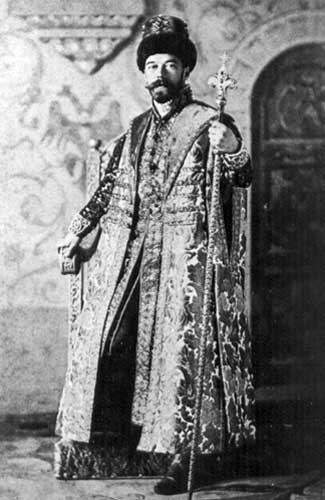
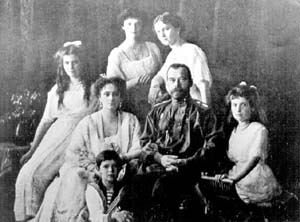
The two icons reproduced here are the myrrh-gushing icons described in this article.
The next day Archbishop Ambrose and a host of clergymen met the myrrh-gushing icon and a myrrh-gushing copy of it in the Transfiguration Cathedral in Ivanovsk. When the icons arrived at the cathedral doors where the Archbishop met them, a multitude of streams of myrrh were gushing forth from top to bottom along the width of both icons, and the whole church was filled with the wonderful aroma of myrrh. The Archbishop placed the myrrh-gushing icon on the altar table and the copy on the prothesis. After the Liturgy, the Archbishop served a moleben. During the entire service the icons never ceased gushing myrrh, spreading their aroma throughout the church. The newspaper stressed that Archbishop Ambrose was the first hierarch of the Patriarchate to receive a myrrh-gushing icon of Tsar-Martyr Nicholas in his home and to pray before it publicly with clergy.
The icons visited several churches for a week in St. Petersburg. The last church on the itinerary was the Theodore Cathedral in Tsarkoye Selo, the Royal Family's favorite church. The church is being speedily restored after having been severely damaged during the seventy-year rule of Communism.
Tsaritsa Martyr Alexandra had been instrumental in bringing traditional, non-Westernized iconography into this church. She purchased icons from Old Believers to hang in the church. With the disappearance or destruction of these icons, it will be very difficult to restore the interior of the Cathedral to its original grandeur. At the service held here for the Tsar icon, the people unanimously sang, "Rejoice, O Tsar Nicholas, the redeemer of the sins of the Russian people."
On the same day, an All-night Vigil was served, followed by Divine Liturgy. Although this was a work day, crowds of people stood in line for hours to venerate the icons. There could be no doubt that the Orthodox people of St. Petersburg are firm in their veneration of the Tsar-martyr and the Holy Royal Family.
However, the same newspaper describes a quite different hierarchical reaction to the myrrh-gushing icon. The ruling hierarch of St. Petersburg, Metropolitan Vladimir, was not at all pleased by the warm welcome received by the icons within his diocese. He said that some people are trying to create a schism in the church. They are arousing passions by demanding the immediate glorification of the Royal Martyrs. Acting like sectarians, he said, they are stirring up the people against pastors and archpastors, and vice versa. The Metropolitan condemned startsy (elders) and all others who venerate the Tsar-Martyr, and declared that all those who receive the icon of the Tsar into their churches will be deposed from their positions or otherwise punished.
Adapted from Church News, v. 11, 1999, pp. 6-7.
